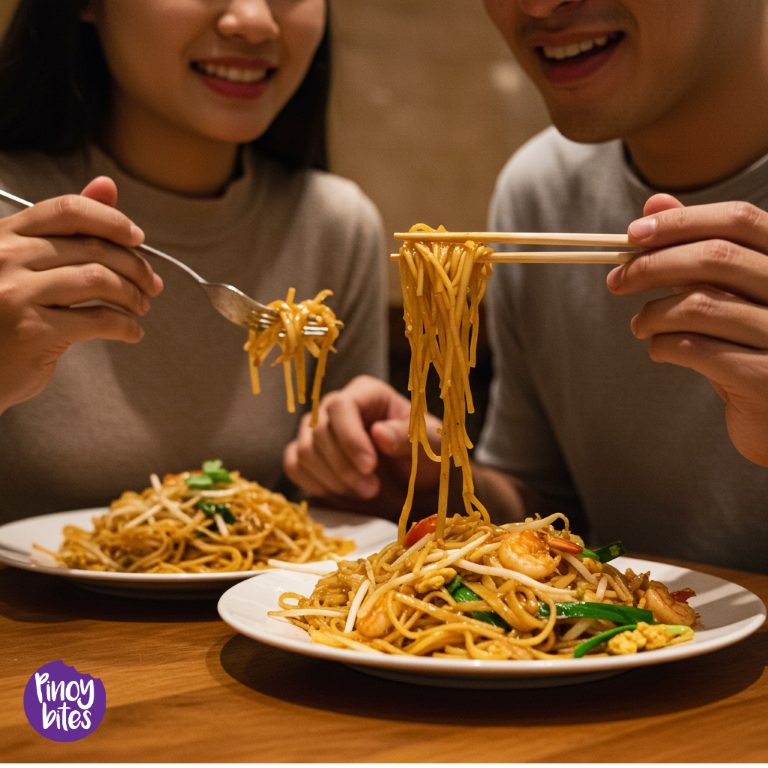Let’s play a quick game. Close your eyes and picture Southeast Asian food. What comes to mind? Maybe the bright herbs of Thai basil and lemongrass, the fiery punch of Vietnamese pho, or the coconut-rich curries of Malaysia. Now, where does Filipino food fit into that mix? If you’re scratching your head, you’re not alone. Filipino cuisine often flies under the radar next to its flashier neighbors—but that’s exactly what makes it so intriguing.
Filipino food isn’t about competing with the Thai, Vietnamese, or Indonesian heavyweights. It’s doing its own thing: bold, comforting, and unapologetically real. Let’s break down how it stacks up against the region’s culinary stars—and why it deserves a spot on your dinner table.
1. Flavor Face-Off: Sour, Salty & Umami vs. Sweet, Spicy & Herbal
Southeast Asian cuisines are all about balance, but they chase it in different ways.
- Thai food: Think sweet, spicy, sour, and salty all at once—like a fireworks show in your mouth. Dishes like tom yum soup or green curry hit you with lemongrass, galangal, and bird’s eye chilies.
- Vietnamese food: Fresh herbs rule here. Pho and bánh mì lean on mint, cilantro, and fish sauce for a light, clean vibe.
- Filipino food: Salty, sour, and umami take center stage. There’s less heat (chilies are often optional) and more tang from vinegar, tamarind, and fermented ingredients. Adobo’s soy-vinegar punch or sinigang’s sour broth are perfect examples.
The twist: Filipino dishes often taste “simpler” at first bite, but they’re layered with slow-cooked depth. It’s like comparing a kicky lime margarita (Thai) to a rich, aged whiskey (Filipino).
2. Ingredient MVPs: Rice, Coconut & Fermentation
Rice is the star across Southeast Asia, but how it’s used tells a story.
- Thailand/Vietnam: Jasmine rice reigns, often as a fluffy sidekick to vibrant mains.
- Indonesia/Malaysia: Coconut rice (nasi lemak) steals the show, paired with spicy sambal.
- Philippines: Rice is life—eaten at every meal, sometimes twice in one dish (looking at you, sinangag garlic rice with silog fried eggs).
Coconut love: While Thai curries simmer in coconut milk, Filipinos use it in desserts (bibingka, buko pandan) and savory stews (ginataang gulay).
Fermentation fiends:
- Korean kimchi and Vietnamese nước mắm (fish sauce) get all the hype, but Filipinos are low-key fermentation wizards. Bagoong (shrimp paste) and patis (fish sauce) add funk to everything, much like Thai nam pla.
3. Street Food Showdown: Bold Bites vs. Portable Snacks
Southeast Asian street food is legendary, but each country has its vibe.
- Thailand: Pad Thai, mango sticky rice, and grilled satay—quick, sweet, and fiery.
- Vietnam: Bánh xèo (sizzling crepes) and bánh mì—crunchy, fresh, and portable.
- Philippines: Comfort with a side of adventure. Balut (duck embryo) isn’t for the faint of heart, but taho (sweet tofu pudding) and isaw (grilled skewers) are pure joy.
Why it’s special: Filipino street food feels like a backyard BBQ—rustic, hearty, and meant to be shared.
4. Colonial Influences: East Meets West vs. Pure Fusion
Southeast Asia’s history shaped its plates, but the Philippines’ colonial past (300+ years under Spain, then U.S. rule) created a wild mashup.
- Vietnam: French baguettes in bánh mì are a rare colonial remnant.
- Indonesia: Dutch influences linger in pastries like kue lapis.
- Philippines: Spanish adobo and leche flan collide with Chinese pancit and American fast food (Spam, anyone?).
The result: Filipino food feels familiar yet unexpected—like a halo-halo dessert (shaved ice + purple yam ice cream + sweet beans) or sisig (sizzling pig face + egg + chili).
5. The Spice Factor: Mild vs. Wild
If Thai food is a chili bomb and Malaysian food a slow burn, Filipino cuisine is more of a gentle nudge.
- Heat seekers: Thai som tam (papaya salad) or Indonesian rendang will make you sweat.
- Filipino style: Chilies are usually optional (siling labuyo on the side). Flavor comes from tangy calamansi lime, vinegar, and bagoong instead.
Pro tip: If you’re spice-averse, Filipino food is your safe zone. If you’re not, add siling labuyo to sinigang for a kick.
6. Comfort Food Classics: Home vs. Restaurant
Filipino food is rooted in lutong bahay (home cooking)—think stews, braises, and family-style spreads. Compare that to:
- Thai food: Often eaten out (street vendors, cafes).
- Vietnamese food: Equally homey, but lighter and broth-focused.
The difference: Filipino meals feel like a Sunday potluck—hearty, carb-heavy, and designed to feed a crowd. A typical spread might include lechon (roast pig), pancit (noodles), lumpia (spring rolls), and kare-kare (peanut stew).
7. The “Wow” Factor: Subtle vs. Spectacular
- Thai/Vietnamese food: Bright colors, fresh herbs, and Insta-worthy presentation.
- Filipino food: Less pretty, more real. Stews might look brown (thanks, soy sauce!), but the flavors are deep and nostalgic.
Think of it this way: Thai food is that friend who shows up in a sequined dress. Filipino food is the one in a cozy sweater, holding a plate of cookies.
So… Which Cuisine Wins?
Trick question! They’re all incredible—they just speak different languages.
- Crave adventure? Hit a Thai or Malaysian spot for explosive flavors.
- Need comfort? Filipino adobo or Vietnamese pho will hug your soul.
- Want something new? Try Filipino sisig (it’s the “next tacos,” according to LA foodies).
The best part: You don’t have to choose. Filipino food’s magic is how it bridges Southeast Asia’s boldness with Spanish, Chinese, and American twists. It’s the ultimate underdog cuisine—quietly delicious, deeply personal, and always ready to surprise you.
Ready to Explore?
- In LA: Compare Jitlada (Thai) and Park’s Finest (Filipino BBQ).
- In NYC: Hit Fish Cheeks (Thai) and Naks (Filipino).
- DIY: Whip up pancit (Filipino noodles) and pad see ew (Thai stir-fry) for a Southeast Asian feast.


